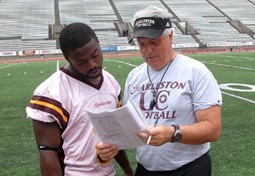I’ve spent a lot of time talking about which stats are “meaningful stats” — the ones that are important — and which stats are “ESPN stats,” or meaningless ones. How many times have you heard an announcer proclaim that Joe Blow just threw for a school record of 500 yards, and oh, by the way, his team is losing!? Or how many times have you heard a coach on the short end of the score say, “We out-gained them by a hundred yards; they couldn’t stop us”?
Comments like these are a result of not understanding the difference between meaningful and meaningless stats. Averages mean nothing because every game has a unique dynamic that has little to do with previous games. The stats that matter are for each individual game.
“Just because a team runs up the score on cupcake teams doesn’t mean it has a good offense.”
The four standard meaningful stats that decide wins and losses are:
— Score more than 25 points in every game, and against the best on your schedule. This is your baseline target. In every game, you should have a game plan to score a minimum of 25 points.
For example, Oregon scored 20 points in the 2015 BCS National Championship game and lost, even though they were averaging double that amount all year. Auburn held the Ducks to 19 and won the national championship in 2010 by the score of 22-19. Averages are meaningless.
Prior to 2017, the loser of the Super Bowl has scored 25 or more points only three times since 1980. (In the 2017 Super Bowl, the Falcons weren’t satisfied with their 28-3 halftime lead and threw the ball. They not only didn’t score, they lengthened the game and gave Tom Brady the time he needed to pull off the greatest comeback in Super Bowl history.)
— Hold your opponent to 16 points or less. This is my definition of playing great defense. If you can’t score 25 points due to your opponent or elements like weather, then hold your opponent to less than 16. If you hold your opponent to less than 16 points, you’ll win 92 percent of your games.
To accomplish this you have to emphasize speed on defense, but you also use your ball-control offense to limit the NUMBER of possessions in the game. Time of possession only matters to an exorcist. But how many possessions your opponent has matters a great deal. Control the tempo on offense, and score touchdowns on a greater number of possessions than your opponent.
Play scorched-earth defense, make them nickel and dime you down the field, and then make them attempt a field goal if they get in the red zone. Keep the ball in front and inside. If your opponent keeps running the ball they are actually helping you shorten the game! The other thing you must do on defense is constantly look for takeaways:

Tony DeMeao
- Put DBs with good hands in the secondary.
- Gang tackle and strip the ball on every tackle once the tackle is secure. Touch the ball on defense on every play.
- Have a turnover circuit every day in practice.
- Be fundamentally sound, good tacklers and play fast. Speed is mandatory on defense.
— Score a non-offensive touchdown, and don’t give up any. If you score a non-offensive touchdown, it hurts your offensive stats but you win. If you give up a non-offensive touchdown, it helps your offensive stats but you lose! A non-offensive touchdown won’t give you any total offense yards (a meaningless stat) or time of possession (another meaningless stat). But you’ll get seven points (a meaningful stat) that will win 90 percent of your games.
This can be done either with a punt return or punt block, a kickoff return, an interception return or a fumble returned for a touchdown. This means putting good return men in the lineup, good hands guys that can go coast to coast. Then practice your special teams with great detail. The following are a few tips to give your team a shot at a non-offensive touchdown:
- Spend time coaching special teams. Make them important. Put good hands and speed on your return teams. If you don’t have a great returner, then develop great punt blocks.
- Coach the cover teams hard so you don’t give up a non-offensive touchdown.
- Be sure you teach ball security so you don’t give up a pick six.
- Practice scoring on defense: “scoop & score” drills and interception return drills.

Brad Pitt as Billy Beane in Moneyball
— Have a plus-2 or more turnover margin. Ball security and getting takeaways are essential to securing wins. It’s all about the ball and who possesses it. So it’s imperative that you have an offense that can score 25 points against every team on your schedule without turning the ball over. In 25 years as a head college football coach, my teams were undefeated when we had a plus-2 turnover margin.
Two second-tier elements that are also important:
— Score touchdowns in the red zone, and force a field goal attempt when your opponents are in your red zone.
— Win the sudden change: stop your opponent from converting turnovers to points, and conversely, convert your opponent’s turnovers into points.
So, how do you build a team philosophy around these stats? In his book Moneyball, Michael Lewis talks about how Billy Beane and the Oakland Athletics built their team around on-base percentage, filling their roster with guys who, first and foremost, could get on base. Typically these were not the highly sought-after, sexy sluggers who earned more money than small countries. Rather, they were guys who were very particular in their pitch selection and thus got on base often. (For more on Moneyball, see http://tonydemeo.com/book-reviews/moneyball-by-michael-lewis/.)
Similarly, our football philosophy was based on controlling the ball. We played guys who could hold on to the ball, and guys who could get the ball. We also went with the quarterback who made the best decisions.
Our first need was an offensive system that could score 25 points against superior talent. Ken Hatfield said that if you are going to win, you either have to be better or be different.
We had to be different. So we installed the “Triple Gun Offense,” which combines elements of the service academies’ flex-bone offense with the quick game of the West Coast offense. The flex-bone is a good offense for “have-nots,” but it has a high risk of turnovers. The goal was to score 25 against the best on our schedule and not turn the ball over. So we learned how to make the Triple Gun Offense low risk. How? That’s a separate article in itself. Check back in this Coaching the Coaches series to read about the “Moneyball Football” philosophy.
We’ve talked about taking care of the football, making good decisions on offense, and on defense emphasizing getting your hands on the ball. There is little doubt of the importance of these Meaningful Stats. Everything you do in your program should be directed at coming out on top of them. Remember, you get what you emphasize. Winning the Meaningful Stat battle may not excite Brent Musburger, but you’ll win a lot of games.
Coach Tony DeMeo
Charleston, West Virgina
Top Photo by Gary Breedlove
Tony DeMeo (Football Analyst) has 25 years experience as a head college football coach, racking up an overall record of 137-108-4. Coach DeMeo recently retired after a six year stretch as the head coach of the University of Charleston, following previous stints at Washburn University, Mercyhurst College, and Iona College. Tony Demeo also spent time as an assistant coach with Richmond, Murray State, Temple, UMass, Delaware, Penn, and Pace University. He has been named Coach of the Year four times, and was elected into the Iona College Hall of Fame in 1997 as a player and coach. He will also be inducted in the Mercyhurst University Hall of Fame in June of 2017 as a coach.
Coach Demeo’s “Triple Gun” offense has set numerous records at multiple schools, and he is an expert on spread offenses, having written numerous books and creating tutorial DVDs on the topic, and is a popular speaker at coaching clinics.
Visit http://tonydemeo.com/ for more information.

